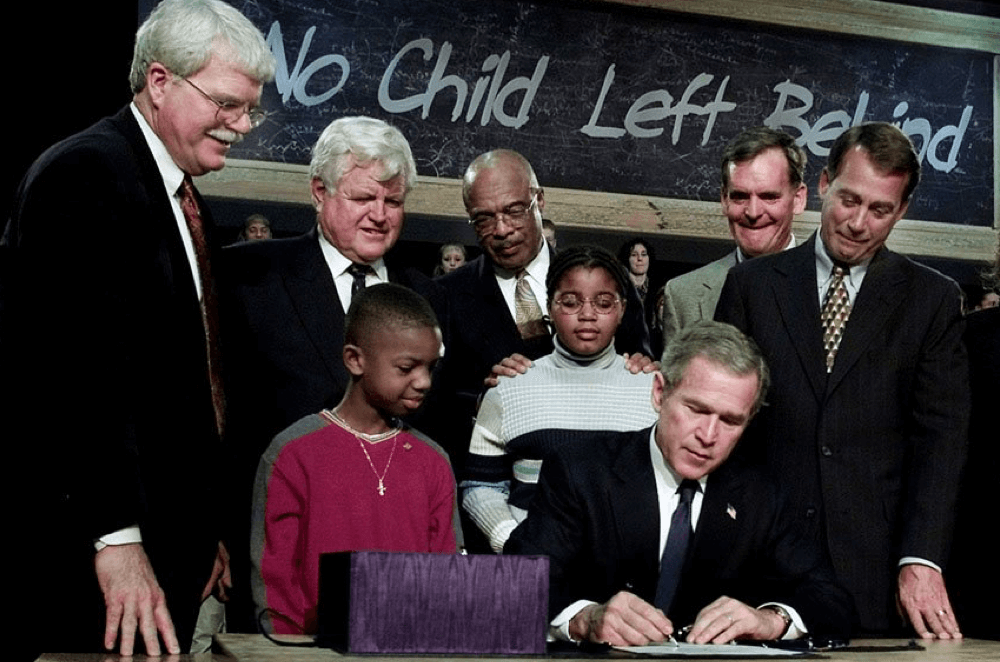Writing a Continuous Standards-Story for Students
Educational reform has taken many forms throughout history. But all reform efforts are based on the premise that improvements made to the educational system will have large returns to society. In particular, in the form of increased well-being and decreases in long-term societal costs.
In the 1980s, a marked change took place in the approach towards educational reform. Prior to this time, efforts to improve education were focused on improving the inputs to school systems. However, a shift began in the eighties—from inputs (curriculum and instruction) to outputs (learning).
The root of this movement was the articulation of academic standards. Standards were intended to provide focus and parameters around what students should know and be able to do in different content areas and grade levels. Yet, articulating the standards was only the first step in the standards movement.
The Beginning of No Child Left Behind
These standards laid the groundwork for No Child Left Behind (NCLB) in 2001. NCLB added a layer of accountability to math and reading standards. Part of that accountability came in the form of high stakes standardized testing intended to ensure schools were teaching the standards and students were successfully learning them.

At the time, accountability and the “stick” versus “carrot” approach was adopted in an attempt to ensure learning. The list of negative consequences for schools that demonstrated less than adequate performance on the new standards-focused standardized assessments was long: decreased school funding, public scrutiny in the form of web and newspaper publications (with headlines often condemning schools and school staff for failing kids), public cross-school comparisons of every kind imaginable, mandated transportation of students from “failing” to “non-failing” districts, loss of district decision-making autonomy, and in some cases, even state “takeovers.” Most of this negative fallout resulted in the unintended consequence of creating fierce competition among teachers, schools, districts and states.
The Evolution of Professional Learning Communities
From this era of evaluation and competition sprang a movement focused solely on collaboration and shared efforts. Rick DuFour was the principal of Stevenson High School in Illinois from the early 1980s to the early 1990s and then served as the district’s superintendent until the early 2000s. During this time, Stevenson High School stood alone in Illinois as the three-time recipient of the National Blue Ribbon School designation. DuFour’s leadership helped pivot teacher planning, teaching, assessing, and responding to data from an individualized to a collective effort in the form of Professional Learning Communities (PLCs).

Over time, the work of PLCs became focused on a four question model that DuFour is credited with articulating. The four questions, that are the focus of work today in schools around the country are meant to focus goals from teaching to learning by shifting from teacher competition and individual efforts to teachers collectively planning instruction and reviewing student data together:

These four questions provided structure for collaboration of educator efforts and kept the focus of teachers’ work on student learning. The thread through all four questions and the foundation for the work of schools are the academic standards (in parentheses below):

Today, there hardly exists a school that doesn’t talk about the center of the work in classrooms as being “standards-driven” and “standards-aligned.” The importance of standards is not something that is in question in American education. However, the struggle that continues to plague schools is creating a continuous standards-story for students.
The Disharmony of Transitions
Transitions tend to provide gaps or breaks in the continuity of students’ standards stories. In schools, these transitions are quite prevalent: transitions from one textbook to the next; from teacher to teacher; from school to school; from the school year to the summer, and into the next school year.
Rather than a seamless, ever-expanding student standards story, schools tend to create short, discrete, disparate chapters. Each chapter exists independent of the next. Some of the chapters repeat; some have a canyon between created by a missing chapter; some are choppy and incomplete; and some are redundant. These disparate chapters don’t allow schools to make the best decisions around standards-targeted education personalized to each of their students. The only thing that remains consistent through it all is the student themselves.
Schools struggle to find a platform flexible enough to bridge all of the inevitable transitions to create a continuous story for each student. Instead, they keep trying to “refine” each of the chapters.
Where Illuminate’s Data & Assessment Can Help
Illuminate Education’s Data and Assessment (DnA) platform allows each student’s standards story to be clear, seamless, and built-on while being layered over across years and transitions. The table of contents for that story are the standards collections that house a districts standards scope and sequence, identifying which standards are taught at what times within a year and from one school year to the next. Standards collections answer DuFour’s first question: What do you want the student to know and be able to do?
With the standards collections in place within Illuminate for each content area and grade or course level, standards-aligned assessments answer DuFour’s second question: How will you know if they know it? Teachers and districts have the ability to pull standards-aligned questions from the item bank or align standards directly from the standards collections to assessments imported from a multitude of other sources including publisher assessments or teacher-created assessments.
Once those assessments are administered, standards-based reports are populated that allow teachers and students to make the best standards-targeted decisions to improve students understandings and abilities. This allows teachers to answer DuFour’s questions three and four: What will you do if they haven’t learned? What will you do if they have?
Illuminate has the tools that enable schools to answer the four essential questions, but they also have tools to seamlessly move through the transitions that disrupt the standards story for each student. Assessments in Illuminate auto populate standards “buckets” (that are aligned to the standards collections) in a standards-based gradebook where students and parents can stay up to date on standards proficiencies through the student and parent portal. The standards-based gradebook also allows the focus to remain on the student’s proficiency of the standards themselves rather than outside factors like timeliness of assignment completion or simply an average of scores determining grades.
Final proficiency levels from the standards “buckets” in the gradebook then populate the corresponding standards fields on the standards-based report card which can also be seen in the portal by students and families.
Because of rostering data fed into Illuminate nightly from the school student information system, everyone with the proper permissions should be able to see that standards-level data for a given student. As teachers change from one school year to the summer and to the next school year, the standards story can be seen and built upon with each new year, each new class and each new teacher. At any time, the standards story can be seen and read in the standards progress widget on each student’s student profile page in Illuminate.
No longer does the standards story get disrupted by changes in teachers, courses, grade levels, schools, school years. No longer does a teacher need to spend the first month of school trying to collect enough data to try to get an idea of the standards-story from the preceding years.
The story stays with the student, where it belongs, and is added onto year after year. The Illuminate tools themselves have a scope and sequence. The power of each tool is maximized when they are used together to weave a continuous standards story for each student. This collective synergy is what makes Illuminate stand apart in its ability to be leveraged for long-term student success.
Would you like to learn more about how our Data & Assessment platform can provide continuity in your school? Contact us today.
*****
Illuminate Education is a provider of educational technology and services offering innovative data, assessment and student information solutions. Serving K-12 schools, our cloud-based software and services currently assist more than 1,600 school districts in promoting student achievement and success.
Ready to discover your one-stop shop for your district’s educational needs? Let’s talk.

